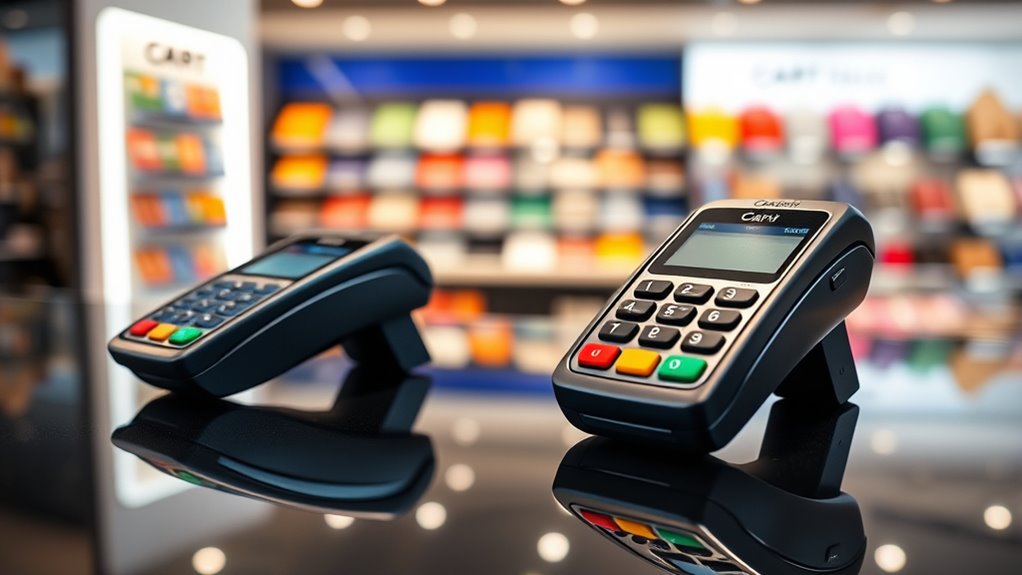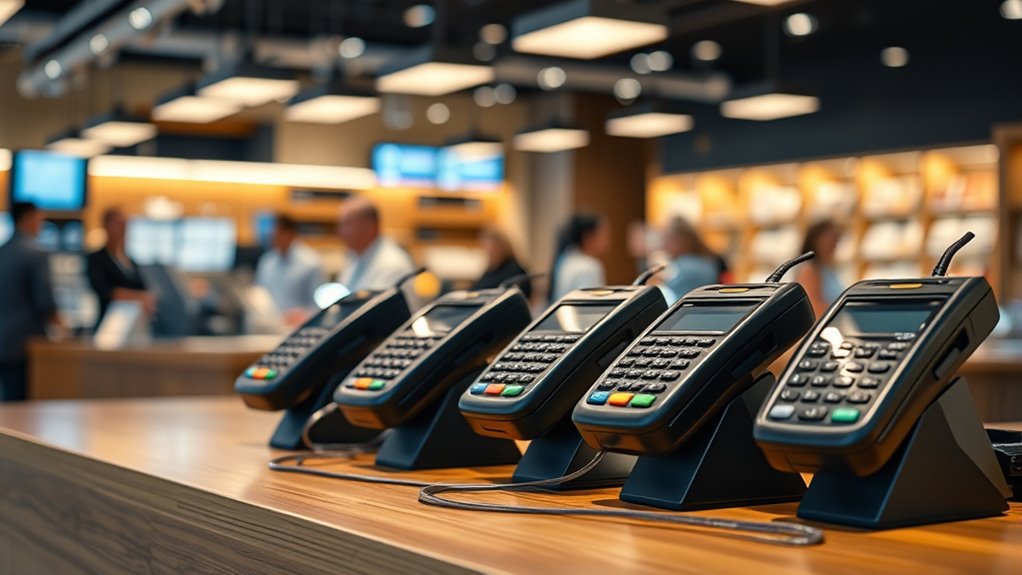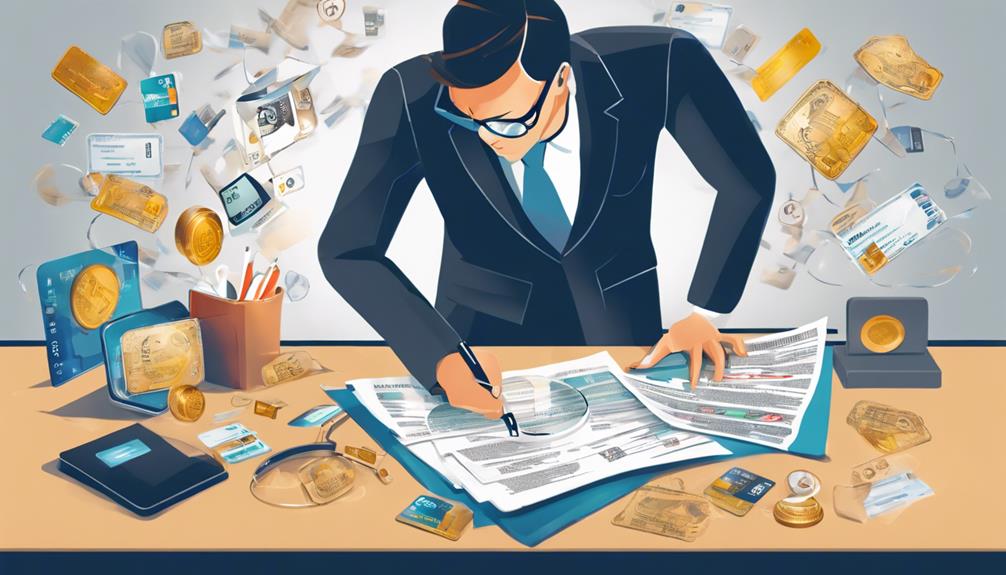Deciding whether to lease or buy credit card terminals depends on your business needs and finances. Renting gives you flexibility, requires less upfront investment, and keeps you updated with the latest technology, but it can cost more over time and limit customization. Buying involves a higher initial expense but grants full control and long-term savings, though it requires handling repairs and updates yourself. Explore more details to find the best option for your business.
Key Takeaways
- Renting provides flexibility and includes support, ideal for short-term needs or evolving technology requirements.
- Buying avoids ongoing fees and offers full control, making it cost-effective for long-term stable operations.
- Rental agreements may limit customization and feature access compared to owning equipment with specific functionalities.
- Purchasing requires a significant upfront investment but eliminates recurring costs and potential rent increases.
- Rapid technological advancements can make owned terminals obsolete faster, while rentals often include upgrades.

Deciding whether to lease or buy credit card terminals is a crucial choice that can impact your business’s cash flow and operational flexibility. Your decision will influence your expenses, technology access, and how smoothly your payment systems run. Renting offers several advantages, especially if you’re starting out or managing a tight budget. It requires little to no initial investment, making it easier to get your payment processing up and running without a large upfront cost. Plus, rental agreements often include the latest technology, so you’re not stuck with outdated equipment. You can upgrade terminals regularly, ensuring you have access to new features and security improvements. Maintenance and support are typically included, which means repairs, software updates, and technical assistance are handled by the rental provider. This reduces downtime and allows you to focus on running your business. Renting also provides flexibility for short-term needs—if you operate seasonally or have temporary locations, you can scale your payment setup easily. Additionally, without long-term commitments, you can terminate or adjust your rental agreements without facing heavy penalties, giving you peace of mind if your needs change.
However, renting isn’t without its downsides. You’ll face ongoing monthly fees, which can add up over time and possibly exceed the cost of buying the equipment outright. Long-term leasing can lead to higher total payments than purchasing, especially if you keep the terminals for many years. Once your lease ends, you won’t own the equipment; it must be returned or re-leased, which prevents asset accumulation. Also, early termination of a lease often incurs penalties, limiting your flexibility if circumstances change. Additionally, rental terminals may not be fully customizable to your specific needs—they might lack certain features or integrations essential for your business operations. The ongoing costs of rentals can significantly impact your budget, especially if your transaction volume increases unexpectedly. Moreover, rental agreements might include clauses that restrict certain modifications or integrations, limiting your operational flexibility. Buying credit card terminals can be more cost-effective in the long run because you avoid ongoing rental fees. Once purchased, you have full ownership and control, allowing you to decide how and when to use or resell the equipment. You also benefit from potential tax deductions, as equipment can be depreciated or deducted as a business expense. Buying gives you the freedom to select terminals with the specific features and software your business requires, ensuring compatibility and customization. Plus, unburdened from rent increases or return policies, you won’t face hidden fees or unexpected costs.
On the downside, a significant upfront investment is necessary to purchase terminals, which can be challenging for new or cash-strapped businesses. Ownership also means you’re responsible for repairs, updates, and support, unless you buy additional service plans. Technology can quickly become outdated, requiring additional purchases for upgrades. You may need staff with technical expertise to troubleshoot issues, and buying might not be the best choice if your payment processing needs are seasonal or fluctuating. Furthermore, rapid technological advancements may render your equipment obsolete sooner than anticipated, leading to additional expenses. Additionally, the risk of obsolescence is higher with ownership, as keeping pace with evolving standards and security features can incur recurring costs.
Frequently Asked Questions
What Are the Hidden Costs Associated With Leasing or Buying?
Hidden costs can catch you off guard whether you lease or buy credit card terminals. Leasing might lead to long-term commitments, hefty cancellation fees, and outdated technology, while buying involves high upfront costs, ongoing maintenance, and potential obsolescence. Additional charges like processing fees, PCI compliance costs, and early termination penalties also add up. Always read the fine print to understand these hidden expenses, so you’re not surprised later.
How Does Lease or Buy Impact Tax Deductions?
Tax tactics transform with your choice. When you lease, you enjoy consistent, convenient deductions, as lease payments are fully deductible each year. Buying, on the other hand, offers a powerful perk—immediate depreciation, especially with Section 179, allowing you to deduct a large chunk upfront. Your decision directly dictates your tax deductions, shaping your savings strategy and impacting your bottom line long-term.
Can I Upgrade Equipment Easily With a Lease?
With a lease, you can often upgrade your equipment more easily than buying outright. Lease agreements typically include options for upgrades during or at the end of the term, sometimes bundled with support and maintenance. However, check your contract for any restrictions, fees, or penalties that could limit your ability to upgrade mid-term. Overall, leasing provides flexibility to stay current with technology without the hassle of reselling or disposing of outdated equipment.
What Are the Long-Term Financial Implications?
In the grand scheme of things, long-term financial implications shape your business’s future. When you buy, you avoid ongoing rental fees, potentially saving money as your transaction volume grows. Leasing or renting may seem easier initially, but over time, costs add up with fixed payments, penalties, and maintenance. You’ll want to weigh these factors carefully, as your choice affects profitability, upgrade flexibility, and overall financial health in the long run.
Is There Flexibility to Switch Providers Later?
When it comes to switching providers later, owning your credit card terminal offers the most flexibility. You can easily switch without worrying about contractual penalties or returning equipment. Leasing or renting, however, ties you to contracts, making it costly and complicated to change providers. You’ll face early termination fees or the hassle of returning equipment. So, if you value flexibility, owning your terminal is the best choice.
Conclusion
Deciding whether to lease or buy your credit card terminals hinges on your business needs. Did you know that over 60% of small businesses prefer leasing because it offers lower upfront costs and easier upgrades? By weighing the pros and cons, you can choose what’s best for your budget and growth plans. Remember, making the right choice today can streamline your transactions and boost your customer experience tomorrow.









